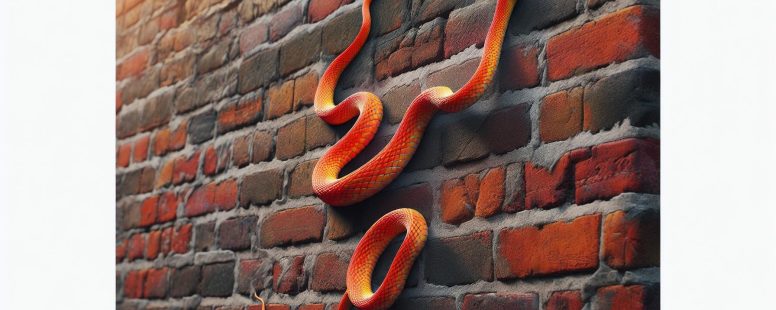Debunking Myths: Can Snakes Climb Walls? Unveiling the Surprising Abilities of Serpents
Ever wondered if your slithery neighbors have a knack for vertical surfaces? Could that garden snake you’ve seen in the backyard suddenly appear on your second-floor window ledge? It’s an intriguing thought, isn’t it?
While we often associate climbing with creatures sporting claws and limbs, nature never ceases to surprise us. In this text, we’ll investigate into the intriguing area of snakes — exploring their capabilities beyond just sliding along flat terrain.
Understanding Snake Movements
Embarking on the journey to comprehend snake movements, let’s investigate deeper into their remarkable abilities. This section unfolds intriguing aspects of how snakes maneuver themselves.
Types of Snake Movement
Snakes exhibit four principal types of locomotion – serpentine, concertina, sidewinding and rectilinear movement. Serpentine motion refers to a wave-like body action used by most species while swimming or moving across slippery surfaces. For instance, it is common in water-dwelling Anacondas and land-based Cobras alike.
Concertina movement involves alternating stretching out and coiling up like an accordion for crawling through tight spaces – seen predominantly among Boa Constrictors exploring tree branches. Sidewinding represents a unique adaptation primarily adopted by desert dwellers such as Rattlesnakes that helps them traverse hot sands without overheating their bodies.
Finally but not least importantly comes rectilinear progression; this “straight-line” technique mostly noticed with large pythons sees them advancing using belly scales while keeping the rest of the body straightened out—a sight similar to caterpillars inching along!
Factors Influencing Snake Movement
Numerous factors influence these reptilian navigations—gravity being one essential component directing many terrestrial organisms’ behaviors including our slithering friends’. High gravity conditions make vertical climbing laborious leading certain species towards opting horizontal travel routes instead.
Secondly are environmental constraints: roughness or smoothness over surfaces greatly impacts snake mobility dictating which type they use more frequently under specific circumstances—for example rocky terrains call for active use concertina-style climbs whereas flat sandy expanses might witness predominant usage sidewise wriggling moves from its inhabitants
Finally yet importantly come inherent physical traits each individual serpent possesses–size strength flexibility all playing vital roles determining what kind best suits them when overcoming challenges within diverse ecosystems they inhabit globally.
Can Snakes Climb Walls?
Snake wall climbing is indeed a fascinating topic that challenges conventional wisdom. This section focuses on the science behind this phenomenon and introduces you to some snake species adept at vertical ascension.
Scientific Explanation Behind Snake Wall Climbing
Snakes, even though lacking limbs, possess impressive capabilities for conquering vertical surfaces like walls. They owe this primarily to their specialized scales and unique muscular structure. Let’s investigate deeper into these aspects:
- Scales: A snake’s belly comprises numerous small scales providing traction against various types of surfaces – smooth or rough.
- Muscles: Snakes harbor long muscles running along their bodies in parallel lines; they contract sequentially from head to tail during movement.
A combination of scale grip and muscle contractions enables snakes’ concertina locomotion up trees, rocks or even walls! Imagine an accordion stretching out then squeezing back together — that’s similar to how concertina-style climbing works!
The surface material plays a role too – while polished glass presents hurdles due its slippery nature; textured walls offer better opportunities for snakes’ upward journey.
This explanation isn’t exhaustive though: research continues uncovering new facets about the incredible adaptability of our limbless friends!
Examples of Snake Species that Can Climb Walls
Certain snake species are more proficient climbers than others – here we spotlight three examples:
- Corn Snakes (Pantherophis guttatus): Native to North America, Corn snakes often climb trees seeking birds’ eggs as food sources.
2.In contrast with common belief around venomous reptiles being terrestrial creatures only—meet the lethal yet agile climber—the Green Tree Python (Morelia viridis). Inhabitants mostly within rainforest canopies; these pythons demonstrate exemplary arboreal skills!
3.And let’s not forget our urban dweller- The Brown Tree Snake (Boiga irregularis) known notoriously for its invasive prowess and high affinity towards climbing, often causing power outages in places like Guam by shimmying up utility poles!
So yes, snakes can climb walls! This astonishing ability varies among species and largely depends on the surface they’re dealing with. But, one thing’s clear: Snakes continue to fascinate us with their adaptive skills in a world dominated primarily by limb-endowed creatures.
Myth vs. Reality: Snake’s Climbing Ability
Exploring through the world of snake locomotion, you’ve unraveled some fascinating truths about these limbless creatures and their diverse movement strategies. But how much of what we believe is grounded in reality? And can snakes really climb walls?
Debunking Common Myths about Snakes
Some myths around snakes’ climbing abilities circulate more frequently than others – let’s tackle those head-on.
- Myth 1: “Snakes Can’t Climb”
Contrary to popular belief, not all ground is a snake’s playground; they’re known climbers too! Several species such as Corn Snakes or Brown Tree Snakes are renowned for their acrobatic prowess. - Myth 2: “All Vertical Surfaces Are Off-Limits For Snakes”
Nope, it isn’t necessarily true either! While surface roughness plays an important role in dictating whether a snake will attempt scaling it, specialized scales and muscular structures empower many types to conquer vertical surfaces with relative ease. - Myth 3: “Gravity Always Wins Against A Climbing Snake”
While gravity does present challenges for any climber—snake or otherwise—it doesn’t always emerge victorious against our serpentine friends!
These misconceptions often stem from incomplete knowledge – so let’s set them straight by digging into some scientific facts on snakes’ ability to ascend vertical terrain next.
Scientific Facts on Snakes’ Climbing Ability
Dive deeper into understanding why certain serpents seem deft at defying gravity:
- Fact 1: Scales Provide Traction
The belly scales (also called scutes) offer grip that aids in creating friction against the surface being climbed — be it tree bark or even your home wall!
2a .Fact 2: Specialized Musculature
Long muscles contracting sequentially propel the snake upwards, while their skeletal structure lends additional support.
- Fact 3: Species-Specific Skills
Not all snakes are created equal in terms of climbing ability. Some species have evolved to be exceptional climbers due to environmental demands or hunting techniques.
With these facts at your disposal, you’re well-equipped to separate myth from reality when it comes to understanding just how adept some snakes can be at scaling vertical surfaces – walls included! Remember though: this doesn’t apply universally across all snake types and circumstances; several factors influence whether a particular climb is attempted or successful for any given serpent.
Impact of Snake’s Wall Climbing on Human Life
Snake wall climbing has significant implications for human life. It presents challenges in residential areas, particularly where snakes are common and their intrusion can lead to anxiety and potential harm.
Precautions to Take When Living in Snake-prone Areas
If you’re residing in snake-prone regions, precautionary measures become crucial. Firstly, regularly inspect your property for signs of snake presence such as shed skins or droppings. Secondly, keep yards clean by removing excess debris like fallen leaves or branches which provide ideal hiding spots for serpents.
Ensure the sealing off crawl spaces under homes – a popular hangout spot for many types of reptiles including snakes that love dark enclosed places. Also check attics often; remember those adept climbers like Brown Tree Snakes? They’ve got no problem reaching high places!
Do not forget about maintaining garden cleanliness too! Overgrown grasses offer perfect cover from predators while also serving as hunting grounds due to ample prey availability (think small rodents).
Regular pest control checks might sound tedious but they help immensely reducing chances attracting these slithering guests into home territory.
Coping with Snake Intrusion: Tips & Tricks
Even though best precautions taken sometimes an unwanted scaly visitor still manages find its way inside our personal space . In event encountering one at home remain calm contact professional wildlife removal service immediately instead attempting handle situation yourself could potentially dangerous especially unaware species involved .
While waiting professionals arrive safely isolate area keeping children pets away avoid provoking snake unnecessarily actions may cause it feel threatened respond defensively resulting bites further complications.
Meanwhile take note distinguishing features if possible aid identification process once experts have arrived – body color , patterns size shape head etc valuable details assisting correct identification so ensuring appropriate handling procedures implemented based specific needs requirements each individual species .
Case Studies of Snake Wall Climbing
In this section, we’re diving into real-life instances that highlight the climbing prowess of snakes in different environments. These case studies provide insight into how these intriguing reptiles adapt to diverse conditions.
Case Study 1: Climbing snake in Urban Environment
Urban areas offer a unique challenge for snakes due to their artificial structures and bustling activity. Take the Brown Tree Snake (Boiga irregularis) as an example, notorious invaders found often around human settlements across Guam.
Brown tree snakes are skilled climbers known for scaling vertical walls with ease thanks to their adept use of concertina locomotion – they anchor themselves using some parts of their body while extending others upwards against gravity’s pull[^1^]. This means even your two-story house isn’t off-limits!
Imagine walking out on your balcony only to find one comfortably lounging there! In fact, numerous sightings report them appearing at astonishing heights by conquering drain pipes or electrical wires^[2^].
This urban-adapted climber not only demonstrates its exceptional ability but also serves as a reminder about maintaining vigilance if you reside in such regions where these serpentine visitors might drop by unannounced!
Case Study 2: Climbing snake in Wilderness
Let’s now shift our focus from concrete jungles onto natural wilderness teeming with Green Tree Pythons (Morelia viridis). Preferring dense forests over populated cities, they showcase another dimension of extraordinary climbing feats^[3^].
Adept at exploring complex arboreal landscapes, Green Tree Pythons make good use both rectilinear and serpentine movements when traversing treetops^.4^. They drape themselves over branches; belly scales gripping tightly while moving steadily towards prey or away from predators.
Even though living high above ground level doesn’t mean it’s always smooth sailing – err– slithering! Natural obstacles like wind sway or broken limbs can disrupt their paths, but these resilient climbers demonstrate remarkable adaptability in overcoming such challenges^[5^].
This case underscores the innate climbing skills of snakes even amidst demanding wilderness conditions. It also emphasizes how varied terrains can shape and influence a snake’s movement techniques.
Conclusion
So, it’s clear that snakes aren’t just ground-dwellers. They’re also adept climbers when the situation calls for it or their environment permits. With specialized scales and a unique muscular structure at their disposal, they can conquer vertical surfaces effortlessly – walls included! Not all species share this skill equally though; some like Corn Snakes and Green Tree Pythons are naturals while others might struggle.
Also, your understanding of snake locomotion now goes beyond the wave-like serpentine movement to include concertina sidewinding and rectilinear progression too. You’ve learned how environmental factors influence these movements as well as debunked common myths about our slithery friends’ climbing abilities.
Remember safety is paramount if you live in a snake-prone area: maintain clean yards conduct regular inspections seal potential entry points consult pest control services where necessary remain calm during an indoor encounter with any serpent species always call in experts rather than tackling them yourself!
Finally witnessing snakes scale buildings or trees may be disconcerting but bear witness to nature’s incredible adaptability even without limbs! These creatures continue challenging what we thought was possible teaching us something new every day about survival tactics within the animal kingdom.
- What Are the Rules for Renting Hot Tubs in the US? Essential Guide for Renters - November 24, 2025
- How Do I Build an Outdoor Storage Building: Step-by-Step Guide for Beginners - November 24, 2025
- Are Gazebos Covered by Insurance? - November 24, 2025




